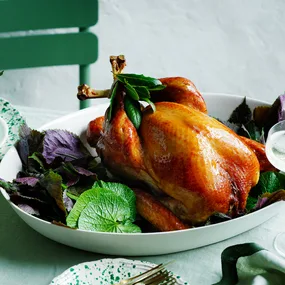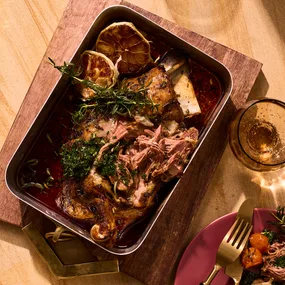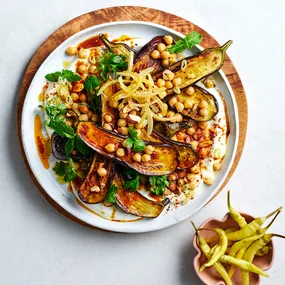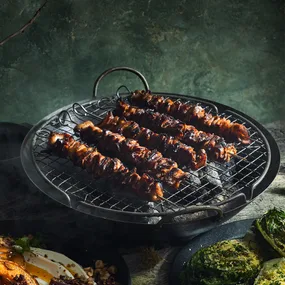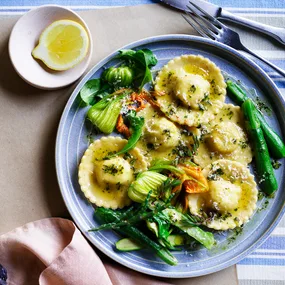Start this recipe a day ahead to marinate the chicken.
In Malaysia, the state of Kelantan, on the north-east coast of the peninsular, is known for its beautiful beaches and laid-back lifestyle. Isolated from the rest of the country until a few decades ago, it’s also the most conservative; the food, however, is anything but. Coconut milk reigns supreme and sugar takes on more than a passing role in dishes that feel vaguely Thai (the state was once a part of Thailand). Think red coconut curry with prawns and vermicelli, for instance.
More importantly, the state has come up with a dish that is seductive and sublime.
It’s the first thing that springs to mind when I want to throw something on the barbie.Ayam percik (in Malay “percik” means to splash) is simply a marinated chicken grilled over an open fire. But what sets it apart from other grilled chicken is the sauce used for basting the bird. Fragrant and smoky, the dish became so popular that it swept through the country like wildfire – so much so it’s now served at Kuala Lumpur’s high-end restaurants. Along the way, the flavours and cooking techniques changed.

An unsung hero, it’s the most fragrant chicken you’ll ever come across. Ayam percik (pronounced “per-chayk”), or chicken with percik sauce, is a street food cooked over coconut embers that pops up at night markets and roadside stalls in that state.

It’s a straightforward dish. All you need is a great free-range chicken – I use Milawa chooks – and a sauce to pep up the grilled bird, and that’s it. But, as with all things simple, it’s the details that matter. For starters, it’s best to butterfly the chicken so it grills evenly, although in Malaysia most street stalls tend to offer barbecued legs wedged between bamboo sticks. Some vendors also precook the legs in the sauce before grilling to speed things up, but I find it robs the dish of its soul.

There are two other elements to consider: you need to marinate the bird well ahead of grilling and the sauce needs to be not only creamy but also a little spicy and tangy without the chilli heat dominating. Candlenuts are used to thicken the sauce and an unusual ingredient, asam gelugor, a sour fruit of the mangosteen family also known as asam keping, adds tang. Sold sliced and dried, it can be difficult to find – Asian grocers are your best bet (you’ll find it’s often mislabelled as tamarind but will have “asam keping” on the packet). Asam gelugor offsets the sweetness of the sauce; at a pinch, you could use tamarind.

Use quality charcoal to perfume the chicken with its subtle smoky aroma. Back in Malaysia, most cooks use coconut charcoal.

I prefer to use binchotan, the Japanese white charcoal made from oak – it’s the Rolls-Royce of charcoal, giving off a steady heat and making for a cleaner finish. You’ll find it at Japanese suppliers such as Chef’s Armoury. You could use an electric or gas barbecue, but it just doesn’t taste the same; nothing beats the flavour of chicken charred over coals. Once you’ve got the charcoal burning, leave it to reduce to glowing embers before popping the chicken on. I like to give it a slow char over low to medium heat so the chicken remains juicy yet still forms the crust from constant basting.


Just to gild the lily, ayam percik is served with nasi kerabu, an exquisite rice salad traditionally tinted blue with butterfly pea flower and packed with herbs and greens such as young cashew and turmeric leaves. These are difficult to source, so I’ve come up with a recipe that’s pretty close to the real thing.

This recipe is quite flexible so adjust the hot, spicy and sour notes to suit your palate. I also like to serve it with a simple tomato and cucumber salad with coriander and a squeeze of lime. Enjoy this excellent meal with a beer or a glass of wine. Happy days.

According to chef Azlan Juri of Kuala Lumpur’s Concorde Hotel, the sauce of the original Kelantan version is much sweeter and packed with lemongrass and coconut milk flavours. Now, he says, most cooks give a spicier twist to the original by adding cardamom, cloves and chillies, and they call it ayam percik utara (“utara” means north). My recipe here is the spicier version.
Ingredients
Method
Main
Note Asam gelugor or asam keping, a dried, sliced sour fruit, and candlenuts are available from select Asian supermarkets and grocers. If asam gelugor is unavailable, substitute 2 tbsp of tamarind purée.
Notes
 Rob Shaw
Rob Shaw

